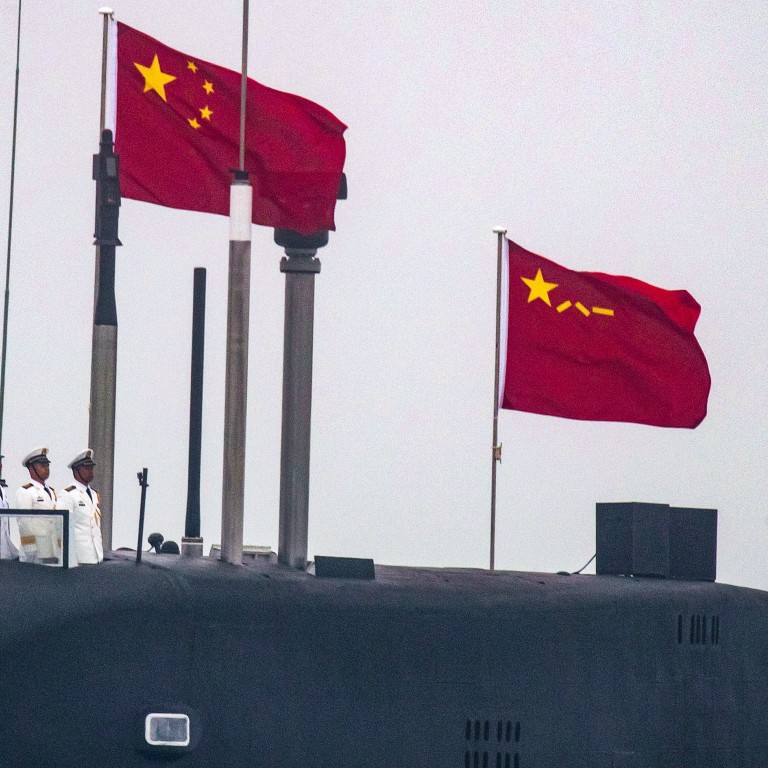
The underwater arms race: China, Aukus and a deepening submarine rivalry
- In the Indo-Pacific many countries are interested in nuclear and non-nuclear submarines and are developing, replacing or expanding their fleets
- The growing number of underwater vessels makes competition between them more dangerous, says academic
On September 30, Chinese foreign ministry spokeswoman Hua Chunying said the move would “not only have a far-reaching impact on the international non-proliferation system, but also bring real threats to regional peace and stability”.
“This is going to be a big threat to China, especially in the South China Sea region,” said Hu Bo, director of the South China Sea Strategic Situation Probing Initiative. “Although Australia’s submarines can’t be delivered in the near future, it will trigger an arms race.”
A 2020 Pentagon report said the Chinese navy had four Type 094A nuclear-powered ballistic missile submarines (SSBNs) in service, six Type 093 nuclear-powered attack submarines (SSNs) and 50 diesel-powered attack submarines. Type 095 SSN and Type 096 SSBN are also under development. In April this year, one more Type 094A entered service, commissioned by Chinese President Xi Jinping in person.
Australia getting nuclear subs via Aukus ‘ups risk of conflict near China’
On the other side, Australia operates six Collins-class diesel-electric attack submarines, and they are planning to acquire “at least eight” SSNs. Although the new vessels will not be operational until after 2030, or even in the 2040s, senior cabinet ministers of Australia have mentioned they may lease some attack submarines from the US or Britain for temporary use or training as a stopgap solution.
The US Navy has the world’s strongest underwater force, with 14 Ohio-class SSBNs and three classes of nuclear-powered attack submarines – Virginia, Seawolf and Los Angeles – making 52 vessels. All the US subs are nuclear-powered and at any given time US Navy fleets have some 24 deployed in the Indo-Pacific.
Additionally, if the US Navy meets its goal of stationing 60 per cent of its warships in the region, it would increase deployment to more than 31 vessels.
Britain, which is geographically far from the Indo-Pacific but has military forces permanently based in the region, has four Vanguard-class SSBNs, four Astute-class SSNs and four Trafalgar-class SSNs in service, plus three more Astute-class and a new Dreadnought-class SSBN in construction. The Astute-class and the Virginia-class are among the candidates Australia may buy.
“Over the next 18 months, Australia will work with the United Kingdom and United States to intensely examine the full suite of requirements that underpin nuclear stewardship,” Australia’s newly formed Nuclear-Powered Submarine Task Force said in a statement.
China is not the only potential opposition for Aukus. In the Indo-Pacific a lot more countries are interested in diving deep. India, North Korea and South Korea have either started or have plans to develop nuclear-powered submarines.
Others are also expanding their underwater strength, even if they are not so keen on using nuclear power. Vietnam is buying from Russia and Thailand from China to bolster its fleets. And as tensions rise with Beijing, Taipei is also eager to replace its pair of aged submarines with new ones.
US vs China: who has the stronger military?
“The US will restrict Taiwan. But it might let Japan and India loose, or even transfer some of its SSN tech to India,” said Song Zhongping, a Hong Kong-based military commentator, pointing out that the two are members of another US-led pact in the region, the Quad, which also involves Australia.
India has commissioned one Arihant-class SSBN, with three more to follow. It has also just returned a Russian-made Akula-class SSN and will lease another one from 2025. And Japan, long focused on it strength below the surface, has 20 diesel-electric attack submarines in service and is building one more.
“Japan and India both have the ability to build their own nuclear-powered submarine. And Japan only needs the green light from the Americans, as do the South Koreans,” Song said.
In January, North Korean leader Kim Jong-un said his country had finished the design of a nuclear-powered submarine capable of firing a “nuclear strategic weapon”, and the development was in “the final stages of examination”.
In response, Seoul has reportedly negotiated with Washington for authorisation to build nuclear-powered submarines. It conducted its first successful underwater test of a submarine-launched ballistic missile earlier this month.
A popular belief is that the best weapon against a submarine is a submarine.
But observers said they were expensive to acquire, operate and maintain. Not every country in the region could afford, or was willing, to build subs. However, the rising tension means those that could not afford to create a new undersea fleet or expand existing fleets would probably also have to seek other anti-submarine warfare (ASW) solutions when caught up in this big boys’ race.
“The ‘cheaper’ solution is to invest in other countervailing capabilities, in this case ASW-capable assets such as purpose-designed surface ships, helicopters and fixed-wing aircraft,” said Collin Koh, a research fellow from the S. Rajaratnam School of International Studies at Singapore’s Nanyang Technological University.
New submarine shows China’s search for stealth in a conflict: analysts
When deployed, many of these submarines are likely to be crowded in the South China Sea, a busy, strategic waterway that is deep enough for submarines.
“The more congested the regional littorals are, the risk of naval close encounters involving submarines and surface forces – as well as accidents such as collisions with other ships including civilian ones – correspondingly increase,” Koh said.
Submarines are essentially “invisible” for the most part while they are navigating and do not surface unless necessary, which makes the underwater competition more dangerous, he said, adding that mechanisms for preventing or mitigating underwater incidents in the region have yet to be developed.

